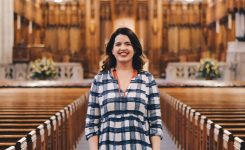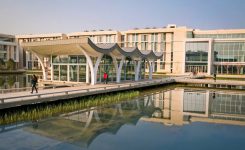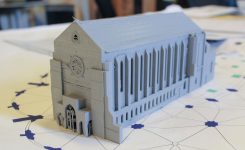Arts & Humanities, Campus
The Duke Arts Renaissance
By Eric Ferreri
In March 2011, renowned composer Steve Reich spent an evening at a downtown Durham watering hole discussing his newest work, which would premiere later that week at Page Auditorium at Duke.
As a crowd filed into the Pinhook that night, Scott Lindroth stood outside, attempting to synthesize what he was seeing.
Scott Lindroth
“The line was spilling out into the street. You couldn’t get in,” Lindroth, then and now Duke’s vice provost for the arts, recalled recently. “There was this whole audience that was in Durham that came out for this conversation, and it signaled to me that something was happening.”
For Lindroth, the evening at the Pinhook was an ‘aha’ moment, a firm indication that something good was happening with the arts at Duke. There was energy swirling around a culture long stuck on the periphery of the academic experience.
And as the arts moved both literally and metaphorically to the center of campus life, it also reached outward to the community. It found parallel momentum in the city of Durham, where arts venues, trendy shops, restaurants and a rehabilitated downtown core were turning a once-stagnant tobacco town into a hip destination.
This month, Duke throws the doors open to the Rubenstein Arts Center, a gleaming new centerpiece for the arts both on campus and in the community. “The Ruby” will serve as a home for the academic and practiced arts and as a symbol that a new, improved and thriving arts culture exists now at Duke. It sits squarely in the center of campus, a new neighbor to the Nasher Museum of Art and a visible bridge of sorts creating an arts corridor between Duke’s East and West campuses.
“What we are ready to do now is to move the arts, to reposition them from the margins of campus and establish them as full partners in everything that goes on here,” said Lindroth.
So how did all this happen?
Soon after arriving at Duke in 1995 as the new curator of the Duke University Museum of Art, Sarah Schroth proposed an ambitious new exhibition to be called “El Greco to Velázquez: Art during the Reign of Philip III,” an examination of two giants and their contemporaries in Spanish art.
One problem: The museum, then housed in a former science building on Duke’s East Campus, had no loading zone.
“There was no way to get the art into the building in a safe way,” Schroth recalled. “The space wasn’t big enough, the ceilings weren’t tall enough. We had climate control, but not in the attic, where a lot of pieces were stored.”
The exhibition was put on hold and the museum’s infrastructure challenges would remain until 2005, when a private gift from Duke alumnus Raymond D. Nasher spurred the building of the new Nasher Museum of Art along Duke University Road. Many on campus point to the eye-catching, 65,000-square-foot modernist facility as an origin story of sorts for Duke’s current arts scene. It legitimized Duke as a place serious about the arts and created a wave of momentum the university still enjoys today.
Sarah Schroth
“It was the first time that Duke and Duke supporters had given money to the arts on the scale they did in order to build a new building and create programs,” said Schroth, elevated to museum director in 2013. “It’s a gorgeous space in a museum that has created very original, ambitious exhibitions. They put us on the map, not only at Duke but internationally.”
The museum quickly began luring high-profile exhibitions – including, in 2008, Schroth’s coveted El Greco to Velázquez show, which Time magazine named one of its top 10 shows of that year. And it became a teaching space as well. Arts faculty began thinking about the Nasher as a place that would allow them to develop and present their own shows based on their research, and the Study Storage program let Duke art students get up close and personal with the thousands of objects the museum was storing for later display.
Gallery view of El Greco to Velázquez: Art during the Reign of Philip III. (Photo by Peter Paul Geoffrion)
“The museum marked a commitment by the university to develop its arts component of university life, which had been underfunded and somewhat, I would say, neglected,” said Peter Lange, who served as provost from 1999-2014 and was a key player, along with presidents Nan Keohane and Richard Brodhead and other administrators, in helping the project come to fruition. “We felt strongly that if we were going to be a great university, we had to have a significant arts programming across a range of things, which the Nasher really symbolized.”
The Nasher was the first in a series of bricks-and-mortar projects boosting the ability of Duke faculty and students to study, create and perform art on campus. The new Rubenstein Art Center follows not just the Nasher but also the rehabilitation of Smith Warehouse, which now houses film, drawing and other art studios; the Arts Annex, a hub for student arts groups; and the renovation of both Page and Baldwin auditoriums on Duke’s West and East campuses, respectively. In particular, the makeover of Baldwin, a stately but outdated venue at the head of the East Campus quad, marked a turning point, many say.
Peter Lange
“This was a hall that was virtually unknown by the community and even, to an extent, by the campus,” said Lindroth. “Overnight, it became a destination. When Duke Performances could present top artists in Baldwin and sell the hall out, it was astonishing. It became a cultural landmark on campus.”
Baldwin Auditorium underwent a dramatic renovation in 2013. (Photo by Duke Photography)
The rise of the arts at Duke was propelled by more than just new buildings, though.
In 2006, Duke’s new strategic plan named the arts as a university priority and called for a new office to coordinate those efforts. In 2007, the Office of the Vice Provost for the Arts was created and Lindroth, a member of the music faculty since 1990, took on the new role. He quickly became a conduit between arts faculty and Duke’s administration.
Tom Rankin
“It certainly sent a message to the faculty,” Lindroth recalled. “They were so excited to have this voice working with the upper administration, advocating for their needs and someone to listen to them and understand the challenges they faced.”
In the new role, Lindroth lobbied for new facilities, faculty positions and other resources. And in reaching up the administrative ladder to the Allen Building, Lindroth found a receptive audience.
“The administration deserves credit for catalyzing and coalescing a lot of the interest that was already here, and giving it a kind of voice and affirmation and seeing it as integral to a major research university,” said Tom Rankin, then director of Duke’s Center for Documentary Studies (CDS).
New money was earmarked not only for renovations and academic expansion, but also to fund an expansion of Duke Performances, which today presents top artists not only on campus but in venues throughout Durham. With new director Aaron Greenwald on board in 2007, an expanded Duke Performances provided an element of cultural entertainment to Duke’s portfolio that Lange, deans and department heads could use when building the faculty, he said.
(Duke also has a long relationship with the American Dance Festival and presents its own Full Frame Documentary Film Festival, each held annually in Durham)
“People have a part of their life which is not work,” Lange said. “People want to be able to go to a good musical performance or a good museum. They want that cultural richness, so if you have that it makes you a more attractive place when you’re recruiting faculty.”
With every new faculty member hired, building renovated and new program approved, the arts at Duke gained more of a foothold. Eventually, the arts became a central piece of the Duke experience. It wasn’t easy, nor fast, but it has happened. With each step, more and more people on campus have become believers.
“Somewhere along the line, enough of us understood that Duke was at the point where it realized art is a fundamentally important component to research, to knowledge and the university’s function in the broader society,” said Esther Gabara, a faculty member since 2001 who teaches courses on Latin American art and other topics. “It’s not something you do at the end of the day to take your mind off things.”
Gabara believed Duke solidified its arts bona fides in 2012 with the creation of the Master of Fine Arts in Experimental and Documentary Arts, the university’s first MFA venture. She points to the MFA program, along with the Ph.D. program in art history and the Nasher museum, as the three critical elements that changed how others viewed Duke’s art scene. The art history Ph.D. program was created in 1989 and 62 students have gone through it.
Esther Gabara
“Those are three things you need; they’re basic,” said Gabara, who holds faculty appointments in the departments of Art, Art History and Visual Studies and Romance Studies. “Those three things have really raised Duke’s profile as a place where art is done and studied seriously.”
(In December 2017, trustees approved Duke’s second MFA program, in dance)
Rankin goes a step further. The former CDS director, who now heads the MFA in documentary and experimental arts program, believes Duke only rounded out its arts portfolio when it substantially expanded programs and facilities focusing on the creation of art – not just the study and display of it.
The new Rubenstein Arts Center is another step in that direction, featuring 10 multipurpose studios and other spaces for students and faculty to create various kinds of artwork on a research-intensive, liberal arts campus with so much else to offer. And it is that holistic approach to education that Rankin and others say will set Duke apart in the future.
“You can go to an arts school and learn lots of skills in the arts, but you can’t easily leave your art class and go take Russian literature or biology or a course in divinity,” Rankin said. “Here, if we do it right and commit to it long-term, an artist can have a liberal arts experience while having all the depth and excitement of an arts school. I think that is our best future here.”
Design by Jonathan Lee
Videos contributed by Julie Schoonmaker and Wil Weldon
Special thanks to the Office of the Vice Provost for the Arts
In recent years, Duke Arts has blossomed along Duke’s central artery, Campus Drive. Explore how the arts have taken root in the map below:
(Map courtesy of Duke Arts)
See more in these arts stories from our archives.









